Silicone Sealant for bathroom
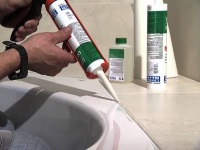
What is it?
All surfaces and equipment in the bathroom inevitably come into contact with water. We are referring not only to direct exposure to water jets, but also steam and condensation that accumulates on the ceiling, walls and furniture. Of course, finishing materials, sanitary ware and interior items in the bathroom are usually made of moisture-resistant raw materials, so increased humidity does not affect their condition in any way. However, even in the most well-equipped bathroom there are areas that we need to protect ourselves from the effects of moisture.
First of all, these are joints between various elements (e.g. inter-tile joints, the gap between the bathroom and the wall, connections between parts of water pipes, etc.). Previously, to seal these areas used bitumen mixture, which could not provide full protection against moisture. In recent years, a silicone-based plumbing sealant has been used for this purpose. This is a modern sealing and adhesive agent, which has a whole set of useful properties.
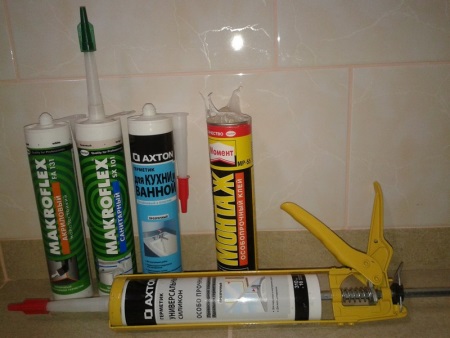
Advantages of
- The presence of silicone in the composition of the sealant provides such a quality as elasticity. Therefore, even after the product cures, the elements of the connection remain movable.
- Silicone sealants are made of silicon, so despite the high degree of plasticity and elasticity, after curing the composition is very strong.
- Silicone-based sealant can be used to connect elements of a wide variety of materials. It works equally well with rubber, plastic, wood, glass, ceramics, etc.
- Once cured, silicone sealant becomes a durable coating that is resistant to a variety of cleaning agents, including those containing aggressive chemicals.
- Most silicone sealants contain fungicidal additives that prevent mold and insects.
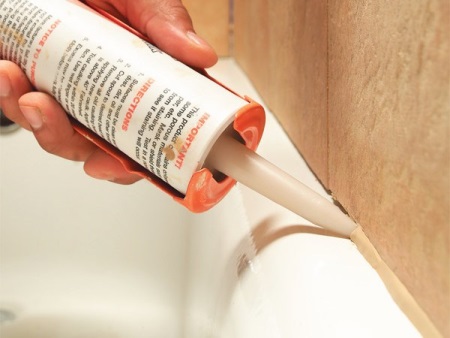
Cons
- In order to apply silicone sealant to the work surface, you must first prepare it: clean from dirt, degrease and dry well. Most silicone sealants lose their properties when applied to a wet surface.
- If the silicone sealant contains most inorganic components, it cannot be painted with ordinary dyes.
- Professionals in the field of repair note that some manufacturers silicone-based sealants poorly connect polypropylene, polycarbonate, polyethylene, fluoroplastic and polyvinyl chloride elements.
It should be noted that all of the above drawbacks apply mostly to silicone sealants of the budget price category. Expensive sealants from reliable manufacturers are of higher quality and are almost completely devoid of these drawbacks.
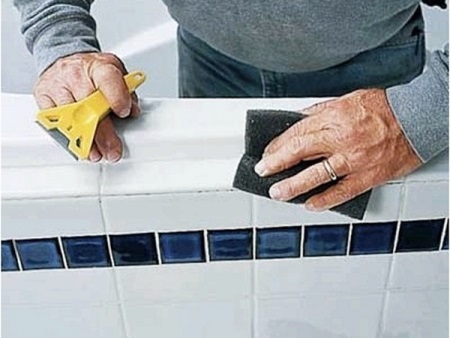
Types
Depending on the composition, there are the following types and subspecies of silicone sealants:
One-component - the most common type of sealants, which is characterized by a wide range of applications. They harden when exposed to humid air. They are usually sold in tubes.
There are three varieties of one-component silicone sealants:
- Acidic - considered a budget option; has a strong vinegar odor. Packages with this type of silicone sealant are labeled with the "A" symbol. Acid sealants contain aggressive chemicals, so they should not be used on surfaces made of fragile materials such as marble.
- Alkaline - have a narrow scope of application, and therefore are rarely used in the home.
- Neutral - a more expensive and better quality group of silicone sealants. There is practically no smell, and interacts well with any materials.
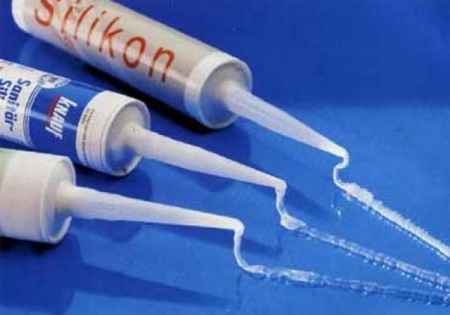
Two-component - to work with this type of sealants you need to prepare a mixture of two active components, which harden, reacting with each other. They are used mainly in industry.
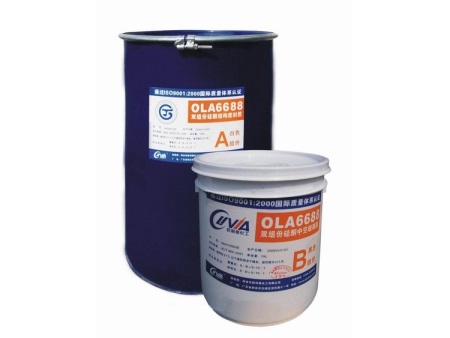
Properties
- Good water resistance - quality silicone sealants are completely impervious to water.
- High degree of elasticity - due to the elasticity of silicone sealants, they can be used to handle moving joints.
- Ability to adhere to materials of different origin - in natural sciences this property is called "adhesion".
- Resistance to high and low temperatures, as well as to sudden changes in temperature - most silicone sealants retain their properties at temperatures from -60 to +300 degrees.
- Resistance to UV radiation - silicone sealants can be used, including for exterior works.
- Resistant to chemically aggressive environments.
- Long service life - silicone sealant is a very durable material that begins to need updating only after a decade and a half or two decades.
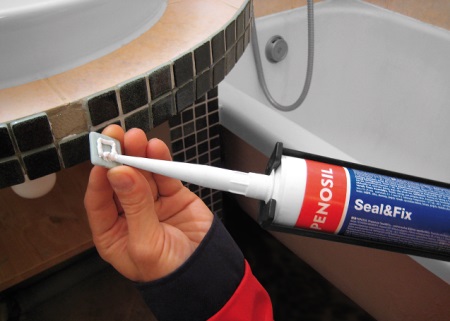
Where is it used?
Silicone-based sealant is used not only for repairs in the bathroom. Its scope of application is quite wide, it includes the following types of construction and repair work:
- roofing work;
- laying of water and sewage pipes;
- construction of glass structures (such as greenhouses);
- laying of natural or decorative stone;
- installation of vinyl cladding material;
- installation of insulating glass units;
- installation of natural stone window sills;
- connection of parts of equipment with high heating temperature;
- installation of various plumbing equipment;
- mirror mounting.
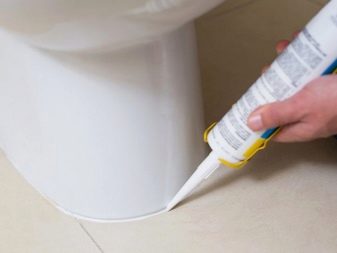
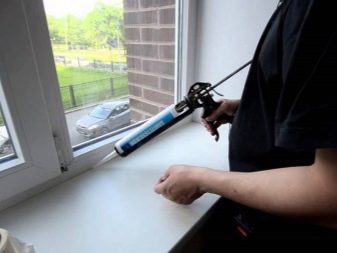
Review of manufacturers - which is the best to choose?
In the market of construction and finishing materials there are dozens of manufacturers of silicone-based sealants. In order not to get lost in the variety of names and not to make a wrong choice, we advise you to give preference to one of the well-established manufacturers.
- Makroflex is a company from Finland, which has been producing sealing compounds for almost 40 years; the products of this brand are highly valued by professional finishers.
- "Moment" is a German brand, which, meanwhile, is well known to the Russian consumer; the company has long had production in our country, so its products are relatively cheap.
- Soudal - silicone sealant produced in Poland meets all European quality standards for this group of building materials.
- Econ, as well as Moment, is a trademark of Henkel Corporation; it is distinguished by convenient modern packaging and fully justifies our idea of German quality.
- Tytan is another product produced by the company from Poland; in addition to silicone sealants, the company Selena, which owns the brand name, produces sealing compounds based on acrylic, bitumen and polyurethane.
- Ceresit - also a product of Henkel Corporation, this manufacturer boasts a wide range of silicone sealants suitable for different types of work.
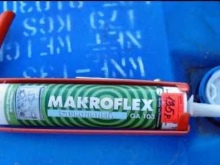
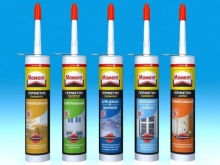
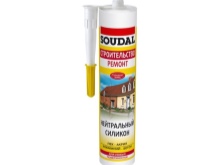
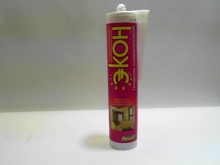
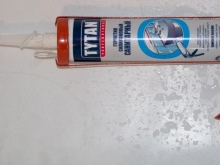
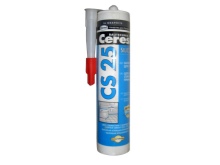
Instructions for use
Silicone sealant is widely used for sealing seams and joints between finishing materials or structural elements of various sanitary equipment. Sealing of joints is usually performed in the following order:
- First it is necessary to prepare the working surface: wash it well, remove dirt, treat it with a degreasing composition and dry it.
- Then tuck the tube with sealant into the assembly gun.
- Then it is necessary to cut the tip of the cap so that the width of the sealing layer coincided with the width of the joint. To do this, you need to choose the right angle of cut.
- Then you need to take care that in the process of working the sealant does not stain the surfaces next to the joint. To do this, cover them with masking tape.
- Now you can proceed directly to the caulking of the joint: Use a spray gun to try to spread the sealant evenly over the joint.
- While the sealant has not set, you can adjust the seam with a special rubber spatula or soapy watered finger.
- Remove the masking tape and wash off any sealant residue with soap and water.
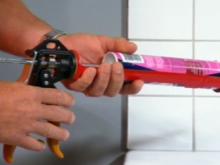
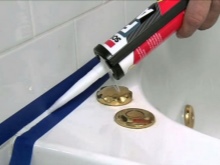
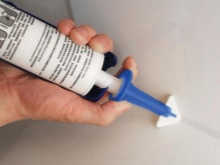
Safety Precautions
First, you must ensure that the silicone sealant is stored in an appropriate environment. Generally, manufacturers recommend that the product be kept away from children, in a dry place at a temperature no higher than room temperature.
Second, when working with the sealant, try not to get the substance in the eyes. And if it did happen, immediately rinse your eyes with plenty of clean water. Silicone-based acidic sealants pose some risk. If you choose to work with this type of sealant, protect your hands with rubber gloves and your respiratory system with a respirator.
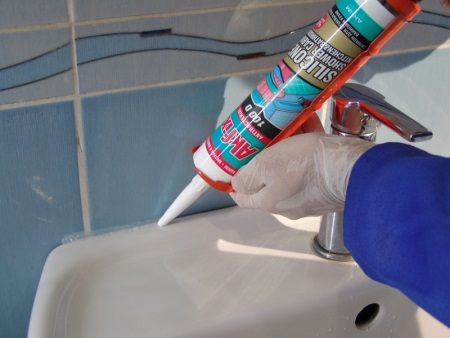
How Long Does It Dry?
The drying rate of silicone sealant depends on several factors: the manufacturer, the thickness of the layer, the material of the working surface, temperature and humidity, etc. It takes 20-30 minutes after application for the compound to dry, but it takes about a day before it is completely dry.
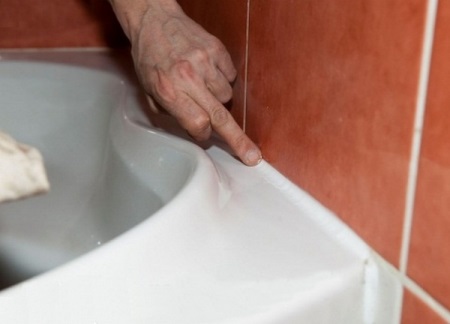
How to remove?
Fresh sealant is easy to remove from all types of surfaces, you just need to wash it with warm water and soap. However, after the composition dries, you will need more effective means to remove it. Most often, various solvents, such as white spirit, are used for this purpose. There are also cleaners designed specifically for silicone compounds. For example, these include Foam-840. It may leave a residue on the surface after use, but it can be easily removed with water and a few drops of lemon juice or vinegar. An antisilicone cleaner is also a good way to remove excess silicone sealant.
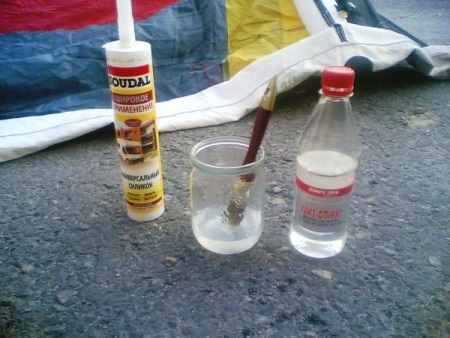
In addition, you can remove the sealant mechanically with a scraper or knife. After that, go over the surface with a dry rag and rub until the surface is clean. This method is only suitable for hard surfaces.

Care
Silicone sealant has excellent performance characteristics, so the seams, treated with this means in a special care do not need. Silicone-based bathroom sealant retains its properties, even being in constant contact with water, at very high or very low temperatures, as well as under the influence of various cleaning agents.




